Some enterprises remain sceptical about the returns on artificial intelligence (AI) deployment. However, a recent report from Bain & Company has cited encouraging gains. Mint explains the state of GenAI adoption among companies today.
Is GenAI moving beyond experiments?
The early movers are going beyond proof of concept (PoC) and trials to deploy GenAI across the enterprise. For them, the landscape is shifting with an ‘AI omnipresence’ kind of approach even though many users are still cautious as they are not sure about their return on investment (RoI). The real value, according to experts, lies not in deployment but in using them widely. That will happen when most employees are encouraged to use GenAI across functions, be it HR, finance, marketing, sales, or customer support. That calls for redesigning internal processes, managing change and explaining outcomes.
Read more: Artificial intelligence needs to serve the interests of everyone
How is Gen AI impacting work?
Enterprises are increasingly seeing GenAI as more than an assistant to their employees. According to Bain & Company’s annual global technology report, the time taken in manual responses at customer service and contact centres, has come down between 20% and 35% over the last 18 months. Sales and marketing teams are spending 30% to 50% less time in content creation. Coding-related activities take 15% less time due to GenAI. The back office, engaged in document processing, is seeing 20% to 50% task automation. The management consulting firm surveyed 200 companies across industries.
How is the AI market changing?
The global market for AI products and services could reach $780-990 billion by 2027, up from $185 billion in 2023. The pace of change will be rapid with AI, as enterprises start getting more bang for their bucks. Cloud service providers and technology companies are leading the change with outcomes like lower latency, reduced costs and better security.
Read more: Smartphone makers are betting big on AI features. Consumers see them as gimmicks
Which functions is AI impacting the most?
AI is being used in software and product development for testing, debugging and maintenance. Customer support is using GenAI for analytics, addressing customer issues and improving virtual agents. Sales and marketing teams are automating social media engagements, customization, account planning, training and support. In the back-office AI is being used for fraud detection, auditing, document processing, drafting reports. The big change is the shift from hype to real use cases with tangible outcomes.
What could be the impact on jobs?
So far, GenAI is in employee assisting mode. Employees are learning how they can improve productivity in real life. The time freed up can be used to improve their own handling of tasks. Though over time, as tasks get automated, the number of jobs in that role may reduce and some of the roles may not exist—firms don’t hire transcribers now as automated tools do the job. Human-machine collaboration will increase, leading to gains for both, in situations like manufacturing.
Read more: Is the iPhone 16 launch really a seminal moment for generative AI?
